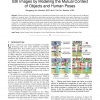143
Voted
PAMI
2012
13 years 3 months ago
2012
—Detecting objects in cluttered scenes and estimating articulated human body parts from 2D images are two challenging problems in computer vision. The difficulty is particularly...
117
Voted
PAMI
2012
13 years 3 months ago
2012
— Most recent approaches to monocular non-rigid 3D shape recovery rely on exploiting point correspondences and work best when the whole surface is well-textured. The alternative ...
144
Voted
PAMI
2012
13 years 3 months ago
2012
A novel system for long-term tracking of a human face in unconstrained videos is built on Tracking-Learning-Detection (TLD) approach. The system extends TLD with the concept of a ...
137
Voted
PAMI
2012
13 years 3 months ago
2012
—There has been a growing interest in exploiting contextual information in addition to local features to detect and localize multiple object categories in an image. A context mod...
132
Voted
PAMI
2012
13 years 3 months ago
2012
—It has been shown that the Universum data, which do not belong to either class of the classification problem of interest, may contain useful prior domain knowledge for training...
127
Voted
PAMI
2012
13 years 3 months ago
2012
— A novel framework to context modeling, based on the probability of co-occurrence of objects and scenes is proposed. The modeling is quite simple, and builds upon the availabili...
121
Voted
PAMI
2012
13 years 3 months ago
2012
—Pedestrian detection is a key problem in computer vision, with several applications that have the potential to positively impact quality of life. In recent years, the number of ...
136
click to vote
PAMI
2012
13 years 3 months ago
2012
—Modeling data with linear combinations of a few elements from a learned dictionary has been the focus of much recent research in machine learning, neuroscience, and signal proce...
148
click to vote
PAMI
2012
13 years 3 months ago
2012
—This paper is concerned with the representation and recognition of the observed dynamics (i.e., excluding purely spatial appearance cues) of spacetime texture based on a spatiot...




